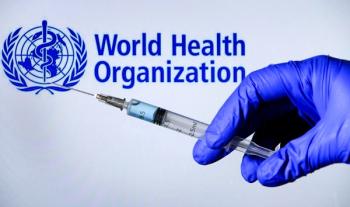
35-Year-Old Man With an Asymptomatic Rash
A 35-year-old man with type 1 diabetes has had an asymptomatic rash on the lower extremities for the past several months. He denies trauma and recent illness. He has tried multiple "home remedies," but the rash has persisted. He smokes and drinks alcoholic beverages occasionally.
The Case:
A 35-year-old man with type 1 diabetes has had an asymptomatic rash on the lower extremities for the past several months. He denies trauma and recent illness. He has tried multiple "home remedies," but the rash has persisted. He smokes and drinks alcoholic beverages occasionally.
Which of these conditions best explains the findings?
- Xanthomas
- Granuloma annulare
- Necrobiosis lipoidica
- Sarcoidosis
(Answer and discussion begin on next page.)
DISCUSSION:
The patient has
necrobiosis lipoidica (NL),
a disorder of collagen degeneration with a granulomatous response. Although the cause is unknown, this disorder is thought to result from diabetic microangiopathy. It is found in about 0.3% of patients with diabetes, especially those with insulin-dependent disease. The presence or progression of the lesions is unrelated to the management of a patient's diabetes.
NL may occur in any age group, including children, although the average age at onset is 30 years. Women are affected 3 times as frequently as men.
The lesions initially appear as 1- to 3-mm reddish brown papules or nodules that evolve over months into depressed yellow atrophic plaques. They have a predilection for the pretibial area but may also involve the trunk, face, and arms. The lesions are often multiple and bilateral. Trauma of the affected area may lead to painful ulcerations. Most patients seek treatment because of concern about the appearance of their skin.
Treatment options for NL include intralesional and topical corticosteroids, antiplatelet aggregation therapy (aspirin or dipyridamole), and surgical excision. However, none of these options is consistently effective. Complications include poor healing, secondary infection, ulceration and, rarely, squamous cell carcinoma.
Although the characteristic lesions of NL are distinctive, atypical presentations may mimic other conditions. These include superficial annular lesions that resemble granuloma annulare and yellow annular lesions that resemble xanthomas. The lesions of sarcoidosis may also be confused with those of NL.
Xanthomas result from an accumulation of lipid-laden macrophages and may be a manifestation of a lipid metabolism disorder. Typically, xanthelasmas are seen in persons older than 50 years, whereas xanthomas may appear at any age. Xanthomas are equally prevalent in men and women; most patients find them a cosmetic annoyance.
Cutaneous xanthomas include tendinous, tuberous, eruptive, and plane xanthomas. Xanthelasma palpebrarum is the most common type of xanthoma. These growths, which begin as small papules and enlarge over months, appear as soft, velvety, macular yellow lesions around the eyelids; they are usually bilateral and symmetric. They are sometimes associated with hyperlipidemia and may also be found in patients who have secondary hyperlipoproteinemia.
Eruptive xanthomas are often pruritic and tender. They commonly appear on the extensor surfaces of the extremities, as well as on the shoulders and buttocks, as small crops of red-yellow papules on an erythematous base. They are associated with hypertriglyceridemia and may develop in conjunction with secondary hyperlipidemias, especially diabetes.
Patients with xanthomas require evaluation for lipid disorders. Treatment is directed at the underlying disorder, if any. Various medical and surgical approaches are available.
Granuloma annulare, an inflammatory dermatitis of unknown cause, is associated with such conditions as tuberculosis, HIV infection, thyroid disease, and diabetes. Clinical variants include localized, generalized, subcutaneous, and perforating forms of granuloma annulare, and arcuate dermal erythema. Localized granuloma annulare most often presents on the extensor surfaces of the legs and arms and on the dorsal surfaces of the hands, fingers, and feet. On the distal extremities, these lesions consist of 1- to 2-mm papules that are flesh-toned to erythematous and often annular. Coalescence of the lesions may produce plaques of 1 to 5 cm; these are sometimes confused with the lesions of NL.
Treatment options include intralesional and potent topical corticosteroids as well as cryotherapy. The lesions of generalized granuloma annulare sometimes persist for decades; spontaneous resolution occurs in 50% of patients within 2 years. The recurrence rate is significant.
Sarcoidosis, a chronic, noncaseating granulomatous disease of unknown cause, most commonly develops between the ages of 20 and 40 years. Women and African Americans are preferentially affected. The lesions of sarcoidosis may occur in many organs and tissues but typically are found in the lungs (90%) and lymphatics (75%) and on the skin (25%). The most common dermatologic manifestation is erythema nodosum. Others include lupus pernio (violaceous lesions of the face or extremities), subcutaneous nodules, and skin plaques. The latter may clinically and histologically resemble the lesions of NL.
References:
REFERENCES:
1.
Belfer MH, Stevens RW. Sarcoidosis: a primary care review.
Am Fam Physician.
1998;58:2041-2050, 2055-2056.
2.
Bello YM, Phillips TJ. Necrobiosis lipoidica. Indolent plaques may signal diabetes.
Postgrad Med.
2001;109:93-94.
3.
Braverman IM. Cutaneous manifestations of diabetes mellitus.
Med Clin North Am.
1971;55:1019-1029.
4.
Freinkel RK. Diabetes mellitus. In: Freedberg IM, Eisen AZ, Wolff K, et al, eds.
Fitzpatrick's Dermatology in General Medicine.
5th ed. New York: McGraw-Hill; 1999:1972.
5.
Ghadially R. Granuloma annulare, actinic granuloma. In: Arndt K, Leboit P, Robinson J, Wintroub B, eds.
Cutaneous Medicine and Surgery: An Integrated Program in Dermatology.
Philadelphia: WB Saunders Co; 1996:438-443.
6.
Leung AK, Fincati M, Schneiderman H. Necrobiosis lipoidica diabeticorum: a clearly described but poorly understood entity with confusing predilection for younger adult diabetics.
Consultant.
2005;45: 1007-1014.
Newsletter
Enhance your clinical practice with the Patient Care newsletter, offering the latest evidence-based guidelines, diagnostic insights, and treatment strategies for primary care physicians.



















































































































































































































































































